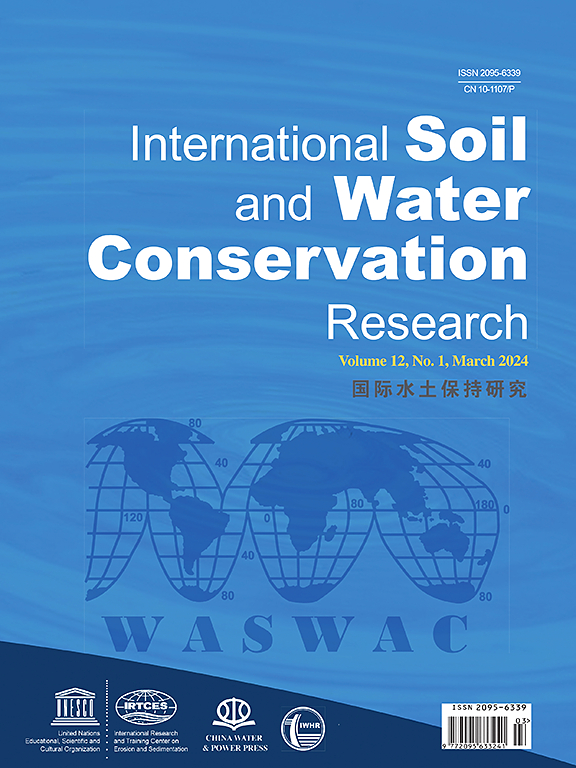底土耕作和秸秆覆盖对土壤碳和结构特征的长期改善具有协同作用
IF 7.3
1区 农林科学
Q1 ENVIRONMENTAL SCIENCES
International Soil and Water Conservation Research
Pub Date : 2025-07-25
DOI:10.1016/j.iswcr.2025.07.011
引用次数: 0
摘要
底土耕作改善了土壤有机碳(SOC)和土壤结构的稳定性和质量。秸秆覆盖与底土耕作相结合可以进一步改善土壤的物理和生物地球化学性质,同时使丰富的秸秆资源得到有效和可持续的循环利用。为了解决这些处理在长期应用和较深层土层的影响方面的知识空白,我们进行了14年的田间试验,分析了高空间分辨率下土壤有机碳、土壤团聚体特征、与不同土壤团聚体尺寸相关的有机碳以及土壤结构稳定性指标的变化。结果表明,SS增加了0.5-2.0 mm团聚体在大部分土壤剖面上的比例,但减少了0-20 cm深度的较小<;0.25 mm团聚体的比例。SS增加了0 ~ 20 cm土层的总有机碳(TOC)、不同粒径团聚体在不同深度的TOC和活性有机碳(LOC)含量、0.5 ~ 2.0 mm团聚体对0 ~ 40 cm土层TOC的相对贡献以及0 ~ 20 cm土层的多种结构稳定性指标。虽然S和SS都改善了土壤性质,但在空间和数量上,SS的改善程度更大。相关分析表明,土壤有机碳、土壤稳定性和团聚体性质的改善是正相关的,这意味着优先考虑SS比S的权衡最小。深埋混合土将前几年施用的秸秆覆盖分解到更深的土壤中,加强了团聚体形成和稳定的相互依赖过程,以及在更广泛的土壤深度产生和保护有机碳。本文章由计算机程序翻译,如有差异,请以英文原文为准。
Subsoil tillage and straw mulching are synergistic for long-term improvement of soil carbon and structural characteristics
Subsoil tillage (S) improves the stability and quality of soil organic carbon (SOC) and soil structure. Combining straw mulching with subsoil tillage (SS) may further improve soil physical and biogeochemical properties, whilst enabling abundant straw resources to be productively and sustainably recycled. To address knowledge gaps regarding these treatments’ effects under long-term application and at deeper soil layers, we conducted a 14-year field experiment and analyzed changes to SOC, soil aggregate characteristics, SOC associated with various soil aggregate sizes, and soil structural stability indicators at high spatial resolution down to 1 m depth. Results indicate that SS increased the proportion of 0.5–2.0 mm soil aggregates throughout much of the soil profile, but decreased the proportion of smaller <0.25 mm aggregates at 0–20 cm depth. SS increased the total organic carbon (TOC) at 0–20 cm, TOC and labile organic carbon (LOC) content of various aggregate sizes at various depths, the relative contribution of 0.5–2.0 mm aggregates to TOC at 0–40 cm, and multiple soil structure stability indices at 0–20 cm. Although both S and SS improved soil properties, the spatial and quantitative extents of the improvements are greater under SS. Correlation analyses indicate that improvements in SOC, soil stability, and aggregate properties are positively correlated, implying minimal trade-offs in prioritizing SS over S. These findings highlight long-term synergistic interactions: subsoiling mixes decomposed straw mulch applied in previous years into deeper soil, reinforcing the interdependent processes of aggregate formation and stabilization, along with SOC generation and protection, across more extensive soil depths.
求助全文
通过发布文献求助,成功后即可免费获取论文全文。
去求助
来源期刊

International Soil and Water Conservation Research
Agricultural and Biological Sciences-Agronomy and Crop Science
CiteScore
12.00
自引率
3.10%
发文量
171
审稿时长
49 days
期刊介绍:
The International Soil and Water Conservation Research (ISWCR), the official journal of World Association of Soil and Water Conservation (WASWAC) http://www.waswac.org, is a multidisciplinary journal of soil and water conservation research, practice, policy, and perspectives. It aims to disseminate new knowledge and promote the practice of soil and water conservation.
The scope of International Soil and Water Conservation Research includes research, strategies, and technologies for prediction, prevention, and protection of soil and water resources. It deals with identification, characterization, and modeling; dynamic monitoring and evaluation; assessment and management of conservation practice and creation and implementation of quality standards.
Examples of appropriate topical areas include (but are not limited to):
• Conservation models, tools, and technologies
• Conservation agricultural
• Soil health resources, indicators, assessment, and management
• Land degradation
• Sustainable development
• Soil erosion and its control
• Soil erosion processes
• Water resources assessment and management
• Watershed management
• Soil erosion models
• Literature review on topics related soil and water conservation research
 求助内容:
求助内容: 应助结果提醒方式:
应助结果提醒方式:


